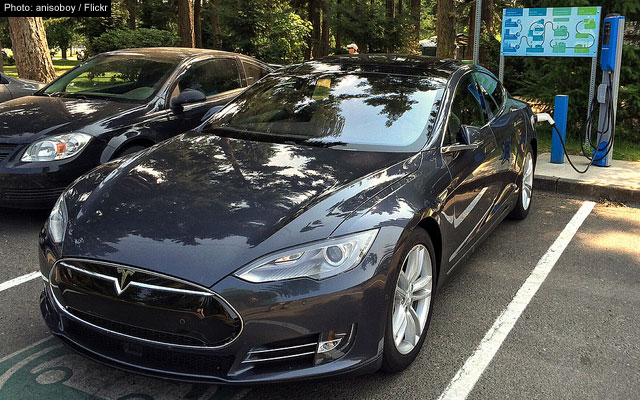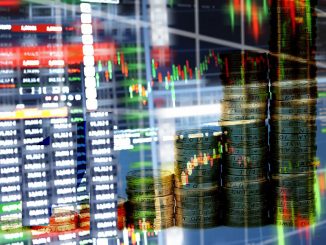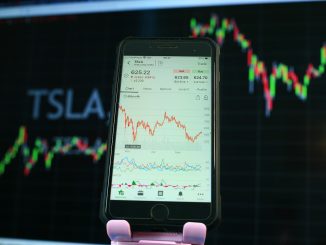Tesla (NASDAQ:TSLA) stock hit an all-time high of $386.99 in late June before sliding and remaining in a volatile trend since then. The name’s price-per-share entered bear market territory by dropping 20% to $308.83 on July 6 after the electric vehicle (EV) company disappointed with second-quarter results. There was so much buzz in Q2 about the arrival of Model 3, the car Tesla is positioning for the average consumer market, that people who wanted to buy a car opted to wait. This cannibalized the sales of Model S and Model X, causing the company to miss its 2Q targets.
Tesla has already burned so much cash that such miss will most likely hit hard the company’s financial standing. It already spent $7 billion by the end of the 2Q, leaving the remaining cash at hand at $3 billion, enough only for three-quarter spending. Tesla has a tricky setup that’s based on debts and lofty ambitions, and analysts say the company’s fate is now depending on Model 3’s success.
Current production of Model 3, however, is still in early stages. Tesla delivered the first 30 units of its much anticipated model this past July but only to its employees; car deliveries to non-employees will only materialize in the fourth quarter. To meet this goal, the Palo Alto, Calif.-based company will have to turn the prototype into a working car by ramping up production: 100 units in August and 1,500 in September until the monthly capacity reaches 20,000 by December. That said, Tesla CEO Elon Musk has warned that his company could face a half-year of “manufacturing hell” trying to increase the production pace of the new Model 3 battery-electric sedan. By 2018, monthly production should reach 40,000 units.
It goes without saying, that sticking with the plan is crucial at this point for Tesla. The company’s management knows full well the repercussions of another disappointing delivery result which will lead to their inability of bringing the Model 3 to market in time to beat the competition. Furthermore, this will unavoidably effect in a negative way Tesla’s share performance. For these very important reasons the company cannot afford any more setbacks.
Outside its facilities, Tesla is also facing external challenges. When the Model 3 was first unveiled a year ago, pre-orders shot up to as high as 518,000, a sign indicating that people are ready to adopt EVs. Later on however, the numbers went down to 455,000. It is also ominous that not all remaining pre-orders will translate into actual sales. In fact, only 70% are sure buyers and, if delivery delays occur, only a small fraction of that number would be willing to wait. (Tesla already had bad experiences of delay with previous models.) Add here, insert issues of quality and tax incentives, and actual sales could deteriorate further.
For now, though, there is little information in terms of how the production of Model 3 is proceeding. That means TSLA will most likely remain volatile until the release of Q3 report.
It should be noted that customers are not the only ones who are having mixed thoughts about Tesla’s ability to meet its production targets. Market analysts are also having their own mixed opinions. In fact, in August only 36% of a total of 22 analysts who covered the company, recommended the name a “Buy”. That compares with 36% issuing “Hold” ratings while 28% called ticker a “Sell”. It is worth noting that the “Buy” calls in August saw an increase of 7% from July. In fact, during the first week of July, major Wall Street firms like Goldman Sachs, Bernstein, and Cowen expressed disappointment over Tesla’s 2Q delivery results in notes to clients.
But despite all the speculations and fickle trends, Tesla remains as one of the best-performing stocks this year. As of Aug 31, the name was trading at nearly $356 a share, a 66% year-to-date spike. Back in July, even Musk himself was in disbelief when he stated that the stock price was “higher than [the company has] the right to deserve”.
But he clarified, or better, tried to hedge that statement on Twitter saying: “Tesla stock is obviously high based on past & present, but low if you believe in Tesla’s future.” Analysts tend to agree; they are positive about the long-term profitability of the EV market and Tesla as a company being at the forefront of it, has the ability to grab even more market share and in the process maximize its profits. (Among others, the company manufactures its own batteries and solar panels and its cars already boast advanced features like autonomous driving.)
For now, one thing appears to be sure: Whatever happens to Model 3 will impact Tesla, for better or for worse.
- Bulenox: Get 45% to 91% OFF ... Use Discount Code: UNO
- Risk Our Money Not Yours | Get 50% to 90% OFF ... Use Discount Code: MMBVBKSM
Disclaimer: This page contains affiliate links. If you choose to make a purchase after clicking a link, we may receive a commission at no additional cost to you. Thank you for your support!





Concentrating on Model 3 success and production is missing lots of issues that Tesla will face in the coming months and next several years. First and foremost is the amount of competition headed their way. The number of electric models that will be forthcoming from the world’s automakers is staggering. AND they are VERY competitive with the three models Tesla produces. And they will have the $7500 tax subsidy that Tesla owners have enjoyed but will lose after less than 50,000 Model 3s hit the road, placing the Model 3 at a severe price disadvantage. Tesla has NO patents to protect their vehicles – any automaker can use the same batteries and electric motors that are found in Tesla vehicles.
Tesla also will no longer be able to collect $150 million per year selling zero emission credits to other automakers in those states where they exist. Tesla is also saddled wih recharging station woes – all of the other automakers will use either CHAdeMO or SAE Combo fast DC chargers, while Tesla uses their own Supercharger protocol.
Tesla is also failing in the service and collison repair arena. Customer relations are horrible. BMW will offer every one of next years models with an electric drivetrain option and Mercedes has several electric models ready to compete against the Tesla Model S and Model 3 and Model X. Ford has 4, GM has 3, etc. Volvo wil only be building electric cars after 2019. etc etc Tesla is about to face something they have never had to face before : competition. Strong competition. And they have exactly 3 models, 2 of which are not affordable for very many folks.
@Kent, you need to do some research. You say that Tesla is saddled with recharging station woes. The charging infrastructure is a key benefit for Tesla. Use plugshare.com to compare the locations of CHAdeMO or SAE Combo chargers. With Tesla chargers you can drive anywhere near the interstate highways. The other chargers are rare outside of major cities, and where they do exists there is only one or two per location.
Your comment about Volvo building electric cars after 2019 is also wrong. They said that they will not build any ICE only cars. All that means is that they may slap a tiny motor on a car and call it a hybrid. Useless mild hybrids have been done many times before. That is not Tesla competition. There is no competition from Ford. GM may compete if it really plans to build more than a token 30,000 cars a year.
More to the point, it’s not just how common Tesla Superchargers are that’s the issue. It’s not even how fast they are (2,5x more powerful than CHAdeMO). It’s the *quality*. If you pick a random CHAdeMO/CCS station, it’s nearly as likely to be out as working. They’re set up by random parties and only as supervised/maintained as said party cares to keep them. Repair times are often measured in months. And there’s only one per location, so if you get there and it’s broken, you’re in trouble.
Tesla specifically avoided this with their supercharger network. Everything is well monitored and serviced quickly. Every station has a minimum of 2 chargers / 4 stalls, and most have well more, so even if one is dead, you can still charge. Tesla’s supercharging network is not only (by far) the fastest charging network, but it’s also by far the most *reliable*.
If you want an EV you can do roadtrips in, get a Tesla. Otherwise, expect your “roadtrips” to be slow and very hit-or-miss.
“When the Model 3 was first unveiled a year ago, pre-orders shot up to as high as 518,000, a sign indicating that people are ready to adopt EVs. Later on however, the numbers went down to 455,000.” This is not true, and it amazes me that some people are still having trouble with this concept.
There never were “518k active orders”. At any point in time, there’s are a given number of new reservations, and some given number of people cancelling. *Over the entire history of the M3 waiting list*, 12% of order holders have cancelled (which should not be at all surprising for a vehicle with a 1-year wait whose features were largely ambiguous through most of its history). But at no point have cancellations outpaced new orders. In particular, after the first deliveries, new orders *shot up*.
It’s not a complicated concept. Get it right.
Tesla has stated it will build 10,000 Model 3 a weeknob in 2018
HOW
They have 1 dedicated production line for the Model 3
They would have to run the line at 79 VPH ( vehicles per hour)
21 hours a day …..gotta give workers lunch and breaks
Where is time for maintenance…Paint booths don’t clean their selfs
6 days a week
No major automotive manufacturers run 79 VPH off one dedicated line
Then you would need perfect quality at that rate or you would fill up your repair area
Yeah I know they have robots so do every automotive manufacturer
Lot of smoke and mirrors at Tesla
I’ve been part of several automotive launches…from the time you make your first saleable vehicle you should be at full production in 4-6 weeks.
At the end of July they released their 1st saleable vehicles and at the end of August they only built 100.
My take on this is they are using their employees for beta test vehicles using Non disclosure agreement not to talk bad about M3 quality….if it walks like a duck it is a duck
Imy not drinking Teslas kool-aid
“They have 1 dedicated production line for the Model 3”
They are currently doing a massive expansion of the Fremont plant for M3 production:
https://electrek.co/2017/07/18/tesla-giant-structure-fremont-factory/
Drive units are also not assembled there; they’re assembled at Gigafactory, then shipped to Fremont.
“I’ve been part of several automotive launches…from the time you make your first saleable vehicle you should be at full production in 4-6 weeks.”
Most automakers wouldn’t have delivered their first vehicles in July; they would have done so in December, when they had more production capacity. Then again, most automakers don’t have nearly half a million reservations.
There is truth to the concept that the reason they’re launching to Tesla employees first is that they’re less likely to complain and more likely to give detailed feedback to Tesla / tolerate any need to get things fixed. But they are not bound by NDAs not to talk about their cars. They can and do chat with people about their vehicles (see any of the Tesla forums where people have run into people with M3s and chatted them up).
And as for “quality”, essentially every review of the vehicle from anyone who’s been in one has been fawning. That’s not to say that production is perfect yet – it’s not. Lots of people on the forum collect spy shots and pick out where they think they see panel gaps or the like. But this is what “production hell” is – scaling up production and streamlining/refining Q/A until the entire process is fast and smooth.
“Imy not drinking Teslas kool-aid”
Nobody asked you to. If you don’t want a rave-reviewed electric car with more standard features than a BMW 3-Series at the same starting price point (*not* counting tax credits or fuel/maintenance savings) with a *minimum* configurable EPA range of 220 miles (max 310) and a *minimum* configurable 0-60 of 5,6s (current max 5,1s, but much lower after the performance version comes out), then nobody is holding a gun to your head and making you buy one.